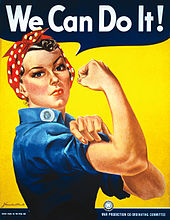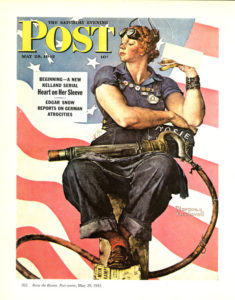World War II was fought as a total war in all countries, which meant that almost everyone was mobilised for war, in one way or another. Although there were many women already working before the outbreak of the war in America, there was an increase from 27% of the workforce to 37% by the end of the war. This could be largely attributed to one of the most popular government campaigns to get women into the factories. The poster used to do that was Rosie the Riveter. Rosie wasn’t just a singular person, but rather a representation of all women during the war. This representation has became a cultural American icon and very popular worldwide.
Rosie the Riveter was first heard in the form of a song of the same name from 1942, written by Redd Evans and John Jacob Loeb. Some of the lyrics of the song were:
All the day long whether rain or shine
She’s a part of the assembly line
She’s making history,
working for victory
Rosie the Riveter

J. Howard Miller’s “We Can Do It!” image for Westinghouse was only displayed in the Midwest during a two-week period in February 1943, but was rediscovered in the 1980s.
It was a very catchy song, and it¬†caught the attention of¬†Saturday Evening Post artist Norman Rockwell. Rockwell painted a young woman named Mary Doyle Keefe who was not a riveter, but rather a telephone operator in Arlington, Vermont. But this woman became¬†the representation of every woman in America. Mary was a small girl, but Rockwell altered her appearance to show the physical strength that women have. ‚ÄòRosie‚Äô held her sandwich in one hand whilst a riveting gun lay perfectly balanced her lap. However, if you look more closely, ‚ÄòRosie‚Äô is resting her feet on a copy of Hitler‚Äôs Mein Kampf manifesto as if to say ‚ÄúHitler who?‚Äù There is also a patriotic American flag that looks like it is being waved in the background of the poster. This piece of art captured the nation and became the biggest propaganda tool for bringing women into working toward the war effort. It depicted woman with strength and courage but also offered the concept¬†that women were equal. Even so, it didn’t matter how awesome these women were during the war, as they could only aspire to being paid half the wages of their male counterparts and had to return back to their wifely duties once the war was over.
-Charleigh Powell
Junior Girl
Girl Museum Inc.

